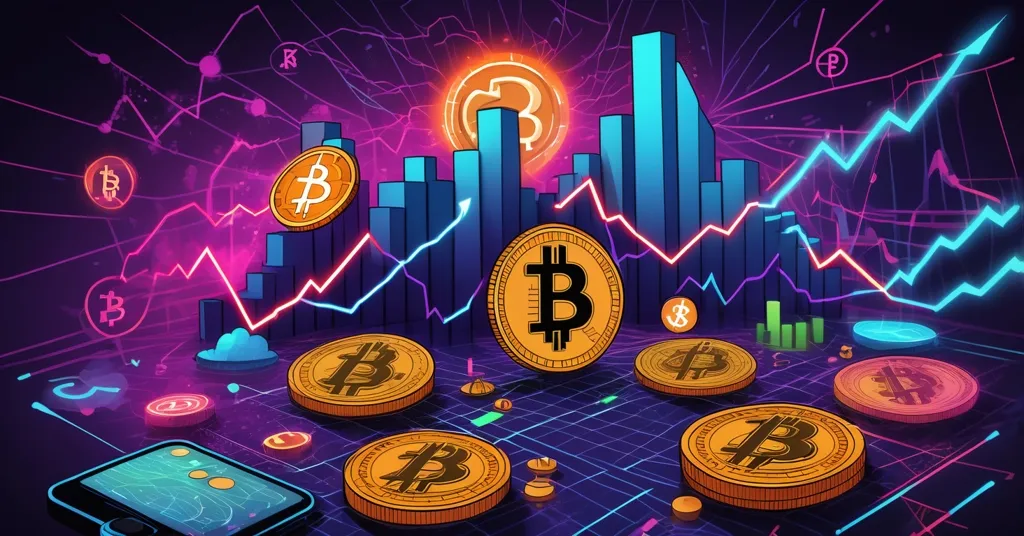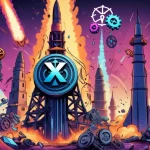Altcoin Frenzy: Pi, XRP, Virtuals, and Snorter Face Hype and Hard Truths in Market Chaos

Bullish Altcoins Under the Microscope: Pi, XRP, Virtuals, and Snorter Amid Market Chaos
The crypto market is a wild beast right now, and despite a brutal smackdown of the much-hyped “Uptober” rally, whispers of a bull run are growing louder if the Federal Reserve throws us a bone. Amid this chaos, four altcoins—Pi Network ($PI), Ripple ($XRP), Virtuals Protocol ($VIRTUAL), and Snorter ($SNORT)—are turning heads with bold promises and speculative potential. Let’s cut through the noise, dissect their value, and slap down the hype with a heavy dose of reality.
- Market Turbulence: “Uptober” derailed by tariffs, with hope riding on Federal Reserve policies for a crypto bull run.
- Altcoin Spotlight: Pi, XRP, Virtuals, and Snorter bring unique plays, from mobile mining to AI and meme coin trading.
- No-Nonsense View: Balancing innovation with harsh truths about risks and speculative nonsense.
Market Context: Why Altcoins Are Stealing the Spotlight
October started with a bang for crypto traders, as the seasonal “Uptober” rally—a term coined by the community for the historical bullish trend in October—pushed prices up with giddy optimism. Bitcoin itself notched a solid 70% gain year-to-date, but the party was cut short by a geopolitical sucker punch: a 100% tariff on Chinese imports announced by President Trump. Prices cratered overnight, wiping out gains faster than a shady token rug pull. Bitcoin’s market cap, hovering around $1.3 trillion as of late October, took a hit but held steadier than most altcoins, with its Relative Strength Index (RSI) sitting at a neutral 52, signaling neither panic nor euphoria. For context, RSI is a momentum indicator ranging from 0 to 100, where above 70 often means overbought (due for a dip) and below 30 suggests oversold (ready for a bounce). It’s a rough guide, not gospel, but useful for gauging sentiment.
Now, the crypto world’s gaze is locked on the Federal Open Market Committee (FOMC) meeting. A dovish stance—think lower interest rates or softer monetary policy—could flood markets with liquidity, often a green light for risk assets like cryptocurrencies. Historically, Bitcoin and altcoins have rallied on such news, as seen post-2020 rate cuts when BTC surged from $10,000 to $60,000 in months. But don’t bet the farm yet; unexpected rate hikes or macro shocks could send us spiraling back to bear territory. In this consolidation phase, while Bitcoin remains the safe(ish) harbor with its decentralized purity, altcoins are where the action is for thrill-seekers chasing 10x gains—or 10x losses. Let’s dive into the four projects making waves, weighing their potential against the very real chance they’ll flop spectacularly. If you’re curious about specific altcoins to watch, check out this detailed breakdown of promising crypto picks for late October.
Pi Network ($PI): Mining Made Easy—or Too Easy?
Pi Network is pitching a revolution in accessibility with its “tap-to-mine” system, letting users earn crypto straight from their phones—no pricey rigs, no energy bills that could power a small village. Think of it as collecting loyalty points by tapping an app daily, except these points might one day trade for real cash. Priced at roughly $0.24 as of late October, Pi has jumped 12% in the last 24 hours, with an RSI of 55 showing decent buying momentum without hitting overbought levels. The big catalyst? A mainnet launch (version 23) on the horizon. For the uninitiated, a mainnet is the real-deal blockchain where transactions happen for keeps, not just in test mode—basically, Pi’s “we’re open for business” moment. If adoption spikes, community chatter suggests a price of $1 by Christmas, quadrupling its value, with some even eyeing $2.50 in the next uptrend.
But let’s slam the brakes on the hype train. Mainnet launches are a minefield—delays, bugs, or low uptake can tank a project faster than you can say “vaporware.” Pi’s user base, reportedly in the millions, sounds impressive, but how many will stick around once mining ends and real economic activity is needed? There’s also the question of value: without a clear use case beyond “mine and hold,” Pi risks being a novelty. Sure, it could onboard masses to decentralized systems, aligning with our push for disruption, but it’s a long shot. Bitcoin maximalists might scoff—where’s the scarcity or security of BTC’s proof-of-work? For now, Pi’s a fascinating experiment, but don’t stake your life savings on it.
Ripple ($XRP): Payments Giant or Centralized Compromise?
Ripple’s $XRP is no small fish—with a market cap over $158 billion, it’s the fifth-largest cryptocurrency, gunning to replace the clunky, costly SWIFT banking system with near-instant, dirt-cheap cross-border payments. Imagine ditching an overpriced, slow international wire transfer for a money-messaging app that settles in seconds. XRP has soared 415% over the past year, peaking at $3.65 in mid-July, though it’s since cooled. Its RSI of 54 hints at steady buying interest. Partnerships with heavyweights like the UN Capital Development Fund bolster its cred, and the recent launch of RLUSD—a stablecoin pegged to the U.S. dollar to minimize volatility—shows Ripple’s hunger to compete with Tether (USDT) in the stablecoin arena. Regulatory wins, like ETF approvals or favorable U.S. crypto legislation, could propel XRP to $5 or even $10, per optimistic community buzz.
Yet, here’s the rub: Ripple’s ongoing SEC lawsuit over whether XRP is a security hangs like a guillotine. A negative ruling could gut its price overnight. More fundamentally, Bitcoin purists—and I lean this way—bristle at XRP’s centralization. Unlike BTC’s sprawling, trustless network, Ripple controls a chunk of validators; reports suggest over 50% of nodes are tied to the company or allies, a far cry from Bitcoin’s decentralized ethos. Could XRP disrupt global finance? Absolutely. But at what cost to the freedom and privacy we champion? It fills a niche Bitcoin doesn’t touch, yet risks being a corporate wolf in decentralized sheep’s clothing. Tread carefully.
Virtuals Protocol ($VIRTUAL): AI Meets Blockchain, But Will It Deliver?
Virtuals Protocol is venturing into sci-fi territory, blending blockchain with artificial intelligence to let users create and invest in autonomous AI agents for games and virtual worlds. Picture owning a slice of a digital brain that runs itself, earning you revenue. $VIRTUAL holders can stake tokens for governance rights and profit shares—a DeFi staple. Staking, for clarity, is locking up your crypto to support a network’s operations, often earning rewards like interest, though with risks of loss if the project fails. Virtuals is up 12% in the last 24 hours, but an RSI of 72 screams overbought, hinting at a possible pullback soon. The concept of democratizing AI ownership is thrilling, potentially challenging centralized tech giants, and aligns with our push for disruption.
However, let’s not sip the Kool-Aid just yet. The AI-blockchain space is packed with contenders like Fetch.AI and SingularityNET, and execution is everything. If Virtuals can’t deliver scalable, usable agents, it’s just another shiny tech fantasy. High RSI aside, adoption hurdles and competition could stall its momentum. It’s a niche Bitcoin wouldn’t dream of touching, and that’s its strength—innovating where BTC’s store-of-value purity doesn’t fit. Still, this is a high-risk bet in a market already littered with broken promises. Keep your skepticism dialed to eleven.
Snorter ($SNORT): Meme Coin Madness with a Trading Twist
Snorter ($SNORT) is the oddball here—a Solana-based meme coin doubling as a trading bot with cross-chain tricks up its sleeve. Solana, for the unversed, is a high-speed blockchain with dirt-cheap fees, making it a playground for meme coin shenanigans. Snorter raised over $5 million in a five-month presale, a eyebrow-raising sum for a name that sounds like a bad party joke. Integrated with Telegram, it offers real-time trading data at a low 0.85% fee, rivaling bots like BonkBot or Maestro. Staking rewards hit a juicy 96% APY (though they drop over time), and influencers are hyping it hard. YouTube’s Borch Crypto claims a “100x upside potential,” while InsideBitcoins calls it a top trading project of the year.
YouTube influencer Borch Crypto says it has 100x upside potential.
InsideBitcoins called it one of the year’s best trading projects.
Let’s get real: this kind of hype is utter nonsense peddled by shills likely looking to pump and dump. Meme coins are the Wild West of crypto—prices can crash 90% on a whim, often driven by tweets or influencer exits. Snorter’s bot utility is intriguing, but without transparency on presale distribution or team credibility, it smells like a potential scam. Bitcoin’s scarcity and ethos tower over this speculative fluff. It’s a niche play for degenerate gamblers, not serious investors. If you touch this, wear a hazmat suit—metaphorically speaking.
The Bigger Picture: Altcoins vs. Bitcoin’s Unshakable Core
As much as altcoins like Pi, XRP, Virtuals, and Snorter bring fresh ideas to the table, let’s not lose sight of Bitcoin’s dominance. BTC’s decentralized, censorship-resistant design—rooted in a fixed supply of 21 million coins and a sprawling network of miners—remains the gold standard for store of value and financial freedom. XRP’s validator concentration, Snorter’s meme-driven volatility, and even Pi’s unproven model pale against Bitcoin’s battle-tested resilience. Altcoins often fill gaps—payments, AI, trading gimmicks—that Bitcoin shouldn’t or doesn’t need to address, and that’s fine. They’re experiments in a financial revolution we’re rooting for. But most will fail, and Bitcoin will endure as the bedrock of decentralization we champion. Never forget: BTC isn’t just another crypto; it’s the reason we’re here.
Risks and Realities: Don’t Get Burned
Before you even think of YOLO-ing into these altcoins, let’s hammer home the harsh truth: crypto is a high-risk game where total loss isn’t just possible, it’s damn likely for the unprepared. Market volatility can flip gains to losses in hours, as we saw with the tariff fallout. Regulatory uncertainty looms large—beyond XRP’s SEC saga, global crackdowns post-U.S. election or EU policy shifts could crush sentiment. Macro factors like inflation spikes or surprise Fed rate hikes can torpedo prices too. Technical indicators like RSI are tools, not oracles, and hype-driven predictions (looking at you, Snorter’s “100x”) are often snake oil. We’re all about accelerating decentralized tech and disrupting the status quo, but blind faith in altcoins is a one-way ticket to broke town. Stay sharp, diversify, and never risk what you can’t lose.
Key Takeaways and Questions Answered
- What crashed the “Uptober” crypto rally?
A 100% tariff on Chinese imports announced by President Trump sent prices plummeting, erasing early October gains in a flash.
- Why is the Federal Reserve’s FOMC meeting a big deal for crypto?
Dovish policies like lower rates could boost liquidity, often fueling bullish runs for Bitcoin and altcoins as risk appetite grows.
- What’s Pi Network’s ($PI) unique hook?
Its “tap-to-mine” mobile app makes crypto accessible, with a mainnet launch potentially pushing prices to $1 by year-end if adoption holds.
- How does Ripple ($XRP) aim to disrupt finance?
XRP targets SWIFT with fast, cheap payments, backed by a $158 billion market cap, though centralization and SEC risks loom large.
- What sets Virtuals Protocol ($VIRTUAL) apart?
It merges blockchain with AI, letting users own autonomous agents, but competition and execution risks could derail its 12% recent spike.
- Is Snorter ($SNORT) a legit investment?
Its Solana-based trading bot and low fees show promise, but meme coin volatility and absurd 100x hype make it a dangerous gamble.
- How do altcoins fit alongside Bitcoin’s dominance?
They experiment in niches like payments or AI that BTC doesn’t cover, but most lack Bitcoin’s decentralized purity and staying power.
- What’s the biggest danger with these altcoins?
Extreme volatility, regulatory uncertainty, and speculative bubbles mean you could lose everything—crypto isn’t a game for the faint-hearted.
- What should new investors prioritize with altcoins?
Focus on fundamentals—use case, team, and community—over hype, and always research risks like centralization or regulatory exposure.
- Can altcoins drive mass adoption of decentralized tech?
Projects like Pi could onboard millions with accessibility, while others like Virtuals push innovative boundaries, though sustainability is questionable.
These four altcoins span a spectrum of innovation, from Pi’s mass-market mining to XRP’s financial upheaval, Virtuals’ futuristic AI, and Snorter’s meme-fueled trading gimmick. Each carries a spark of potential to carve out a role in the decentralized future we’re fighting for, yet none rival Bitcoin’s raw, unassailable strength as the ultimate middle finger to fiat decay. Altcoins are the wildcards—some may soar, most will crash and burn. We’re all about effective accelerationism and pushing boundaries, but let’s not kid ourselves: this revolution is messy, brutal, and littered with casualties. Keep your wits sharp, your skepticism sharper, and remember that true financial freedom comes with a hell of a fight.



